MAXIMIZING ALUMINUM FOIL USES IN RESTAURANTS: PRO GUIDE
INTRODUCTION: ALUMINUM FOIL – THE SECRET WEAPON TO ELEVATE RESTAURANT KITCHENS
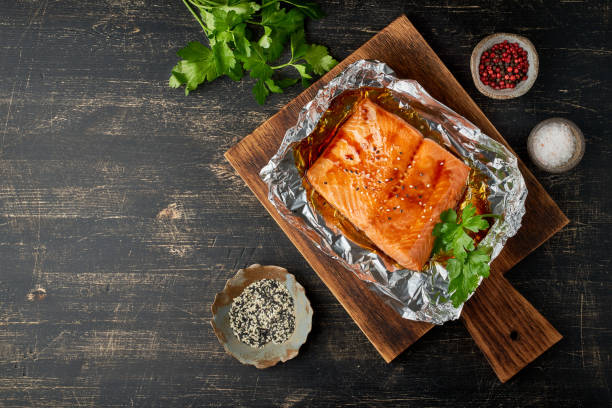
Pull Quote: "For a restaurant kitchen, aluminum foil isn't just a utility; it's a strategy for quality control, time optimization, and enhanced customer satisfaction."
PART I: WHY ALUMINUM FOIL IS AN INDISPENSABLE "ASSISTANT" IN PROFESSIONAL RESTAURANT ENVIRONMENTS
1.1. Ensuring Consistent Food Quality
Optimize moisture retention: It prevents water loss during cooking (grilling, steaming). This helps meat and fish stay tender and moist. Vegetables retain their freshness.Distribute heat evenly: When wrapping food, foil helps heat spread more evenly. This avoids situations where the outside is burnt while the inside is still raw."Seal in" flavor: It fully preserves the characteristic aroma of the dish and spices. These are not lost to evaporation or mixed with other kitchen smells.
1.2. Optimizing Preparation and Cooking Processes
Pre-preparation and portioning: Food can be marinated, portioned, and pre-wrapped in foil. It is ready for cooking upon request. This saves considerable time during peak hours.Minimize cleaning: Using foil to line baking trays or wrap food limits grease and sauce spatter. This shortens cleaning time for utensils.Versatile utensil use: A single tray can be used for many different dishes when lined with foil.
1.3. Enhancing Food Preservation Efficiency
Prevent cross-contamination: Tightly wrapping food in foil limits air exposure. It also limits bacteria from the environment or other foods.Maintain freshness longer: For some vegetables and fruits, foil wrapping can help them stay fresh. It also limits bruising.Frozen storage: Foil helps prevent "freezer burn" on food during frozen storage.
1.4. Superior Food Safety and Hygiene Solutions
Foil creates a physical barrier between food and contact surfaces (trays, grills). This reduces contamination risk. Single-use ensures maximum hygiene for each serving. This is especially important for large-scale service models.
1.5. Flexibility in Presentation and Service
Foil can be shaped into temporary "molds" or decorative items for dishes. Packaging takeaway food in foil retains heat well. It also creates a clean, professional look.
PART II: DIVERSE ALUMINUM FOIL USES IN RESTAURANTS – UNLOCKING ENDLESS POTENTIAL
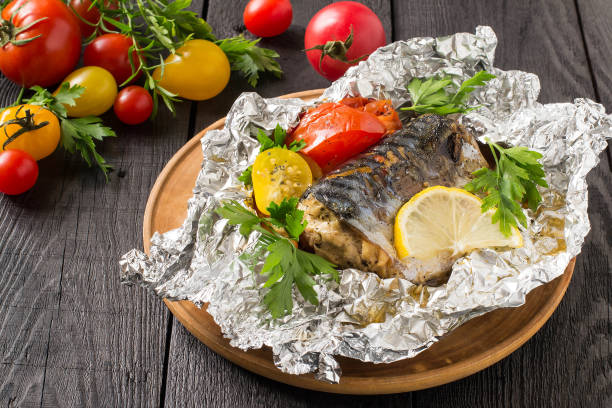
2.1. In Food Preparation – The "Silent Hero"
2.1.1. Roasting & Grilling Techniques: Retaining Flavor, Creating Perfect Crusts Directly wrapping food: Helps meat, fish, and vegetables cook evenly from the inside out. It retains natural moisture. Juices and spices are not lost, infusing deeply into every fiber.Practical example: Foil-baked salmon with lemon and dill. Foil-wrapped BBQ ribs. Foil-roasted mixed vegetables.
Lining baking trays: Prevents food from sticking to trays, simplifying cleaning. It also helps reflect heat, browning the underside of food evenly.Covering surfaces: When roasting whole chicken or duck, using foil to cover easily burnt parts like wings and drumsticks initially helps the entire dish achieve an even golden-brown color without charring.
2.1.2. Steaming: Tender, Moist, Nutrient-Rich Dishes Creating individual "steam pouches": Each portion of seafood or vegetables is wrapped separately in foil with spices, then steamed. This method helps each serving retain its unique flavor without mixing. Maximally preserves vitamins and minerals compared to direct boiling.
2.1.3. "Sealing" Flavors for Braised and Stewed Dishes When braising or stewing meats that require long cooking times, covering the pot opening with a layer of foil before putting on the lid helps seal in steam better. This makes the meat tenderize faster and absorb spices more deeply.
2.1.4. Shaping and Molding Food Foil can be folded into temporary molds for baking cakes, making panna cotta, or shaping terrines and pâtés when specialized molds are unavailable. Maintains the shape of rolled meats or sausages during steaming or roasting.
SUMMARY BOX: CORE BENEFITS OF ALUMINUM FOIL IN FOOD PREPARATION
⭐ Moisture & Nutrient Retention: For tender, delicious, nutritious food.♨️ Even Heat Conduction & Distribution: Helps food cook evenly, prevents burning.🌿 Flavor "Lock-in": Preserves the dish's characteristic aroma.🧼 Reduced Cleaning: Limits grease adhesion to utensils.
2.2. In Food Preservation – Extending Ingredient "Lifespan"
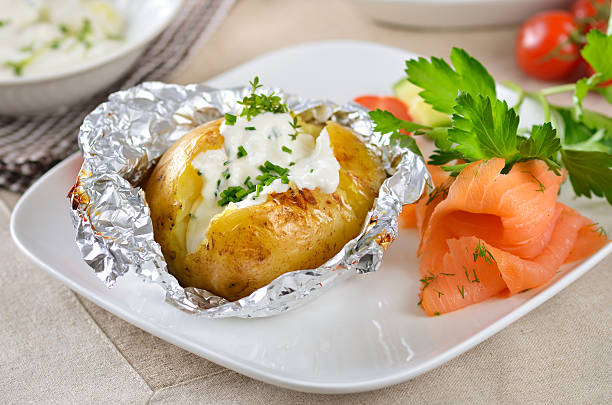
2.2.1. Preventing Moisture Loss and Cross-Contamination Tightly wrapping prepared meats, fish, and vegetables helps prevent them from drying out when stored in refrigerators or chillers. Creates an effective barrier, preventing odors from one food from transferring to another. It also limits bacterial entry. Quick tip: Wrap each type of food separately for best preservation results.
2.2.2. Effective Frozen Food Storage Using heavy-duty aluminum foil to wrap food before freezing helps prevent "freezer burn." This is when the food surface dries out, changes color, and loses flavor due to cold air exposure. Ensure all air is pressed out before sealing tightly.
2.2.3. Keeping Food Warm Before Serving After cooking, dishes can be wrapped or covered with foil to keep them hot while awaiting service. This is particularly useful for buffets or when preparing dishes in advance.
2.3. In Service and Presentation – Elevating the Customer Experience
2.3.1. Takeaway Packaging: Professional and Appealing Using foil to wrap grilled, fried, or stir-fried takeaway dishes helps retain heat well. It ensures the food is still hot when it reaches the customer. It provides a cleaner, more hygienic, and upscale feel compared to some common plastic containers. Note: For dishes with a lot of sauce or high acidity, line the foil with parchment paper.
2.3.2. Creating Decorative Accents for Dishes Foil can be cut and shaped into small decorative details for food plates. This adds appeal and sophistication. Using colored foil (if food-safe types are available) can create a distinct look.
2.3.3. Lining Serving Trays: Clean and Convenient Lining serving trays with foil makes cleanup easier. It keeps trays hygienic and provides a shiny, clean appearance.
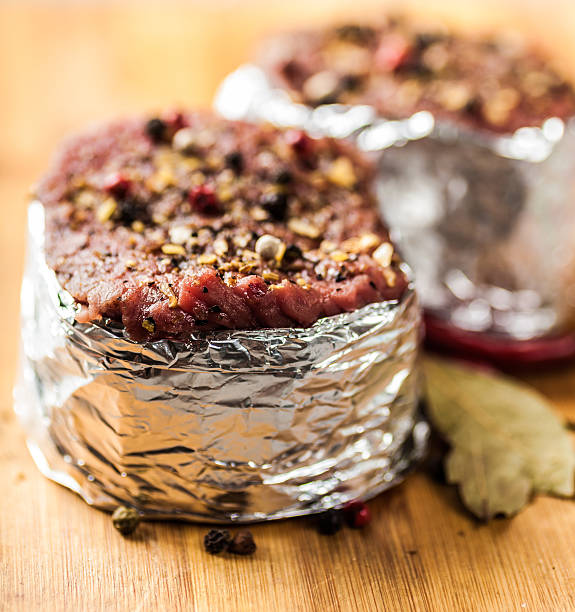
2.4. Other Smart Applications in Restaurant Kitchens
2.4.1. Cleaning Kitchen Utensils A crumpled ball of used (not too dirty) foil can scrub stubborn stains on grills or metal pots (except non-stick surfaces).
2.4.2. Temporary Knife Sharpening In emergencies, folding foil into multiple layers and cutting through it several times with a knife can temporarily improve its sharpness. WARNING BOX: (Desired presentation: Box with a red border or warning icon, light-colored background.) Caution: This is only a temporary fix. It cannot replace professional knife sharpening with proper tools. Overuse can damage the blade.
PART III: SELECTING AND USING ALUMINUM FOIL SAFELY AND EFFECTIVELY IN RESTAURANTS
3.1. Criteria for Choosing High-Quality Aluminum Foil for Commercial Kitchens
Thickness and Durability: Key Factors Prioritize heavy-duty or extra heavy-duty aluminum foil. They offer better heat resistance. They are less likely to tear when contacting sharp bones or during robust wrapping. Thickness also helps retain heat more effectively. It reduces the risk of food charring.
Food Safety Certifications: Top Priority Always choose products from reputable brands. Look for "food-grade" labeling on the packaging. This ensures the foil is free from harmful contaminants that could leach into food.
Appropriate Sizes and Packaging Formats Large rolls of wide foil are more convenient and economical for frequent, high-volume restaurant use. Boxes with sharp, easy-to-use cutters are also a plus.
3.2. Golden Rules for Using Aluminum Foil with Different Food Types
Minimize direct contact between foil and these foods for long periods, especially at high temperatures.Alternative solution: Line the foil with parchment paper. Parchment paper is heat-resistant and does not react with acids.Do not use foil to store highly acidic leftovers in the refrigerator for extended periods.
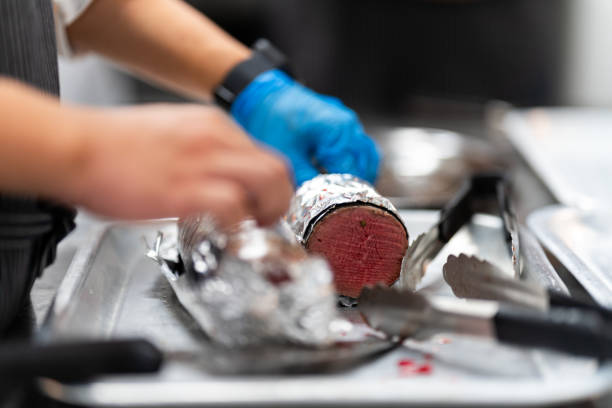
Do not use foil in microwave ovens (unless specifically permitted by both microwave and foil manufacturers). Avoid prolonged direct contact between foil and open flames, which can cause it to burn.
QUICK COMPARISON TABLE: STANDARD FOIL VS. HEAVY-DUTY FOIL
3.3. Optimizing Costs and Minimizing Foil Waste
Use the correct size needed; avoid excessive cutting. For some non-direct food contact applications (e.g., covering), foil can be wiped clean and reused (consider hygiene). Explore local aluminum recycling programs to dispose of used foil responsibly.
PART IV: CASE STUDIES: ALUMINUM FOIL USES IN RESTAURANTS IN PRACTICE
4.1. Fine Dining European Restaurant: The Famous Foil-Baked Salmon
Context: An upscale European restaurant known for fresh seafood.Foil Application: Preparation: Fresh salmon fillets are marinated with olive oil, white wine, dill, sliced lemon, salt, and pepper. Each portion is then carefully wrapped in heavy-duty foil with asparagus spears and cherry tomatoes. The packets are baked in an oven at a precisely controlled temperature.Benefits: Fish cooks evenly, retaining its natural sweetness and moist tenderness; it does not dry out. The aromas of wine, lemon, and dill deeply infuse the fish. Asparagus and cherry tomatoes cook to perfection, retaining color and crisp-sweetness. Preparing individual packets ensures consistent portioning and quick service on demand.
Presentation: The foil packet can be partially opened at the guest's table, creating an appealing release of fragrant steam.
Outcome: The dish is not only delicious but also visually appealing, reflecting the restaurant's sophistication and professionalism.
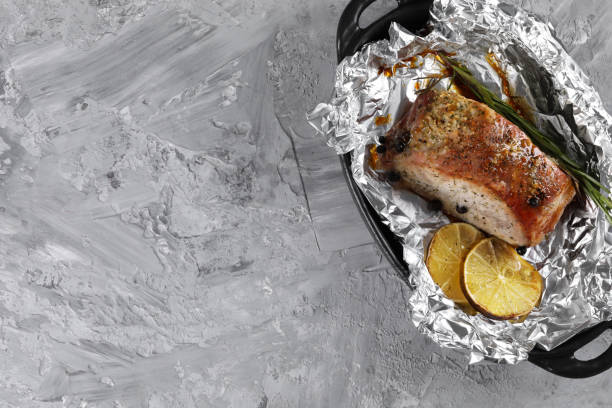
4.2. Asian Restaurant: Flavorful Whole Foil-Roasted Chicken
Context: A restaurant specializing in Asian cuisine, particularly traditional roasted dishes.Foil Application: Preparation: A whole free-range chicken is cleaned and thoroughly marinated with a signature spice blend (five-spice powder, garlic, shallots, lemongrass, honey, soy sauce). The entire chicken is then wrapped in multiple layers of foil, ensuring a complete seal. It's roasted over charcoal or in a tandoor-style oven with carefully managed time and temperature.Benefits: Chicken cooks tender to the bone; meat is sweet and not dry. The skin inside the foil remains moist and deeply infused with spices. The characteristic spice flavors are perfectly "sealed" in, not lost. <small>For crispy skin, after the chicken is nearly cooked, chefs can carefully open the top foil layer and roast directly for a short additional time.</small>
Outcome: The foil-roasted chicken becomes a signature dish, attracting diners with its intense flavor and unforgettably tender, sweet meat.
4.3. Buffet Service: Keeping Food Warm and Attractively Displayed
Context: A large hotel hosting a buffet with hundreds of diverse dishes.Foil Application: Keeping warm: Many cooked dishes (like roasted meats, steamed fish, stir-fried vegetables) are placed in chafing dishes and covered with a layer of foil to maintain a stable temperature, preventing food from cooling and drying out.Display: Some special dishes can be presented in small, neat foil packets, creating curiosity and appeal for diners.Lining trays: Food trays are often lined with foil for easy replacement and cleaning, ensuring the buffet station always looks clean and presentable.
Outcome: Food quality is better maintained throughout the buffet duration, while also enhancing the aesthetics and hygiene of the service area.
PART V: "FURTHER READING" AND REFERENCES
5.1. Food Safety Standards Related to Contact Materials
Research regulations from your local Ministry of Health or international organizations (like FDA, EFSA) regarding materials in direct contact with food, including aluminum. Suggested Internal Link: [If an article on "Food Safety Standards in Restaurants" exists, link it here]
Certifications like HACCP and ISO 22000 also have specific requirements for utensil and material use in food preparation.
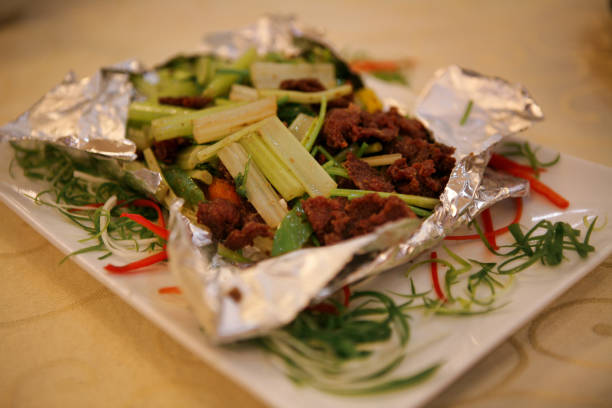
5.2. Trends in Sustainable Material Use in the F&B Industry
Explore more environmentally friendly alternatives to foil for certain applications (e.g., bagasse containers, banana leaves for traditional wrapped dishes). Learn about aluminum recycling programs and how to responsibly dispose of used foil to minimize environmental impact.
DEFINITION LIST OF RELATED TERMS
Food-grade Aluminum Foil: Foil manufactured and tested to meet safety standards for direct contact with food, free from harmful substances that could migrate into food. Heavy-duty Aluminum Foil: Foil with greater thickness and durability than standard foil, suitable for applications requiring better heat resistance and tear strength, such as grilling or campfire cooking. Freezer Burn: The phenomenon where the surface of frozen food becomes dry, dehydrated, and texturally altered due to exposure to cold air during prolonged freezing, often from improper packaging. Cross-contamination: The transfer of bacteria or other pathogens from one food item to another (often from raw to cooked) or from utensil surfaces to food.
CONCLUSION: ALUMINUM FOIL – A RELIABLE PARTNER FOR RESTAURANT SUCCESS
Call to Action:
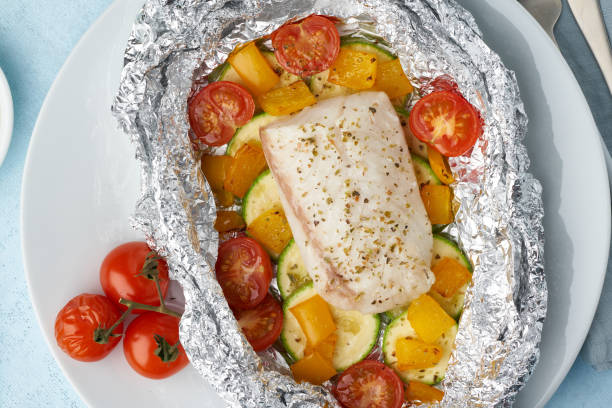
FREQUENTLY ASKED QUESTIONS (FAQ) ABOUT ALUMINUM FOIL USES IN RESTAURANTS
Q: Which type of aluminum foil is best for restaurants? A: It depends on the intended use. Heavy-duty foil is often preferred for grilling, roasting, or applications requiring high durability. Always ensure the product is certified food-grade.Q: Does using aluminum foil increase a restaurant's operational costs? A: If used intelligently and efficiently (right type, right size, maximizing functionality), foil can help save costs in other areas, such as reduced cleaning time and less food spoilage. However, wasting foil will certainly increase costs.Q: Should restaurants worry about aluminum from foil leaching into food? A: Yes, especially with highly acidic or salty foods. Preventative measures, like using parchment paper liners and limiting direct contact time at high temperatures, should be applied. This demonstrates care for customer health and professionalism.Q: Are there eco-friendlier alternatives to aluminum foil in some cases? A: Yes. For storage, specialized food containers with tight lids can be used. For some traditional roasted or steamed dishes, banana leaves or dong leaves can be interesting options. Oven-safe dishes with lids are also good solutions to reduce single-use foil.Q: How can restaurant staff be trained to use aluminum foil correctly and safely? A: Develop clear guidelines for foil usage, including food safety notes, selecting foil types for specific purposes, wrapping techniques, and post-use disposal. Conduct regular training sessions and monitor compliance.
Loc Tu: Pioneering Excellence in Premium Aluminum Packaging Solutions
Why Choose Loc Tu:
✅ Assured Quality & Safety: Crafted from premium, food-grade aluminum, free from harmful impurities, meeting international safety benchmarks.
🔥 Optimal Thermal Properties: Ensures even cooking and excellent heat retention, preserving food temperature and taste effectively.
💪 Durable & Convenient Design: Engineered to resist leaks and dents, providing reliable performance for baking, storage, and transport.
🔄 Versatile Solutions: Our extensive range caters to various applications – from baking and steaming to storing fresh food and takeaway meals.
🌱 Eco-Conscious Packaging: Made from 100% recyclable aluminum, supporting sustainability and reducing plastic waste.
🎯 Brand Enhancement: Optional custom printing available to personalize products and boost your brand visibility.
🚚 Reliable Supply & Delivery: Capable of handling large orders with dependable, on-schedule nationwide shipping.
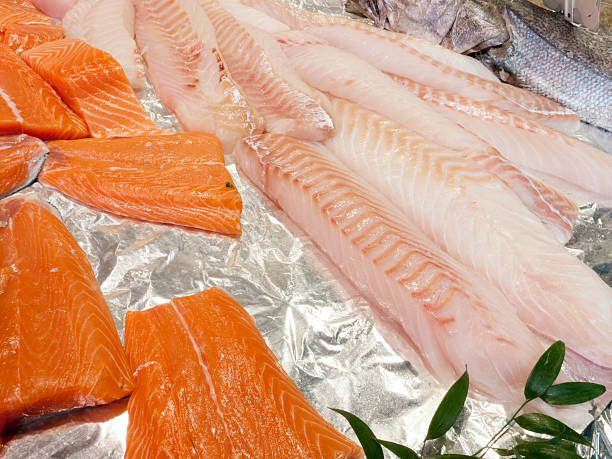
Your Trusted Partner in Food Packaging 📞
📌 LOC TU MANUFACTURING & TRADING CO., LTD
📌 Website: ALUMINUMFOILVN
📌 HOTLINE/ZALO: +84.969.787.309
📌 Facebook: Khay nhom thuc pham
📌 Youtube: Khay nhom thuc pham Loc Tu
📌 Tik Tok: Khay nhom Loc Tu
📌 Shopee: Khay nhom thuc pham Loc Tu
📌 Telegram: Khay Nhom Thuc Pham Loc Tu
📌 Whatsapp: +84.969.787.309
📌 Branch 1 (Hanoi): No. 1 Pham Tu, Beasky Building, Dai Kim Ward, Hoang Mai District, Hanoi
📌 Branch 2 (Binh Duong): No. 68, DX 051 Street, Group 17, Quarter 4, Phu My Ward, Thu Dau Mot City, Binh Duong Province
📞 Contact us today for expert consultation and the best pricing on premium aluminum trays, foil, and food packaging solutions! 🚀
LOC TU PRODUCTION AND TRADING COMPANY LIMITED
Branch 1 (Binh Duong): No. 68, DX 051 Street, Group 17, Quarter 4, Phu My Ward, Thu Dau Mot City.
Branch 2 (Hanoi): No. 1 Pham Tu, Beasky Building, Dai Kim Ward, Hoang Mai District.
Hotline/Zalo: +84.969787309
Website: Khaynhomthucpham.com
Email: [email protected]